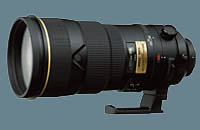
| Home Reviews Forums News 2015 2013 2012 2009 2008 2007 2006 2005 2004 RSS Feeds FOV Factor Table Sensor Sizes | Definitions: A-D E-H I-L M-P Q-U V-Z | Sitemap Articles Archived Websites (Pre-DigitalDingus): D100 Lounge E-10 Club | Contact |
| AF-S VR Nikkor 300mm f/2.8G IF-ED |
| September 16, 2004 |
 TOKYO Nikon Corporation is pleased to announce the introduction of the AF-S VR Nikkor 300mm f/2.8G IF-ED, a new high speed super-telephoto professional lens for Nikon digital and 35mm SLR cameras now with Vibration Reduction (VR) technology, focus preset functions, Meniscus front element and the first Nikkor lens to feature Nikons Nano-Crystal anti-reflective coating, all to deliver professional quality sports and action photography. TOKYO Nikon Corporation is pleased to announce the introduction of the AF-S VR Nikkor 300mm f/2.8G IF-ED, a new high speed super-telephoto professional lens for Nikon digital and 35mm SLR cameras now with Vibration Reduction (VR) technology, focus preset functions, Meniscus front element and the first Nikkor lens to feature Nikons Nano-Crystal anti-reflective coating, all to deliver professional quality sports and action photography.The new lens begins with Nikon technology that was incorporated into the AF-S Nikkor 300mm f/2.8G IF-ED II. With Silent Wave Motor Autofocus Performance, Internal Focusing, Nikon ED Glass for extra-low dispersion, and G design for use with Nikon SLR models that feature Command Dial and Sub-Command Dial control, the lens has been extremely popular among professional photographers. The lens features optimum performance among Nikons selection of compatible SLR models, including the newest selection of 35mm SLR models and the new Nikon F6 and all of Nikons D-Series Digital SLR cameras D1, D1H, D1X, D2H, D100 and D70 as well as the newly announced D2X. The first addition to this already fast and powerful lens is the benefit of VR (Vibration Reduction), an innovation that makes it possible to take sharper handheld shots especially when limited to shooting at slower shutter speeds than normally thought possible. This provides the advantage of being able to shoot more effectively in indoor and outdoor locations under dimmer lighting. With a 300mm lens, most photographers would limit their choice of slow shutter speed to 1/300 second. With the VR Advantage, one could expect to shoot with the slowest speed that is up to about 3 speeds slower as low as about 1/30second! Nikons VR technology further enhances picture taking potential with a choice of two modes to match more shooting conditions. VR Normal Mode primarily compensates for camera shake, and includes automatic panning detection as well as automatic tripod detection. VR Active Mode effectively compensates for vibration in situations where it is more pronounced and more frequent, such as when shooting from a moving vehicle. Complimenting the adoption of VR technology is the addition of an easy access row of controls on the side of the barrel. The Focus Mode switch enables instant switching between M/A (Manual-Priority Autofocus) and M (Manual Focus) modes; the Focus Limiter switch restricts AF-servo movement to a selected shooting distance range; the AF-L switch makes it possible to lock onto a chosen focus point from the lens; AF-ON engages autofocus from the lens, (in addition to the switch on the camera body); and Focus Preset instantly recalls a preset focus distance, an important feature to aid when shooting sports and you wish to instantly return to a specific distance setting such as home plate in baseball or the team's goal in soccer. The AF-S VR Nikkor 300mm f/2.8G IF-ED also benefits from the application of Nano-Crystal Coating to selected elements, which provides superior anti-reflective properties that virtually eliminate ghost and flare and provide clear and vivid images when shooting under powerful sunlight or indoors under spotlights. Created and honed in the process of developing Nikons advanced NSR (Nikon Step and Repeat) semiconductor manufacturing device, this marks the technology's first introduction in a photographic lens and in a consumer product. Also new is a meniscus protective glass element. Nikkor lenses have traditionally incorporated optical and mechanical designs carefully implemented to prevent internal reflection, and the meniscus element succeeds in minimizing ghosting that can occur when light reflected off a digital cameras image sensor goes back up the lens barrel and reflects off an ordinary flat protective glass element. Compatibility with Nikon's TC-14EII (1.4x), new TC-17EII (1.7x), and TC-20EII (2.0x) teleconverters extends the flexibility and total reach of the lens to as long as 600mm when mounted on a 35mm film SLR, and the same angle of view as a 900mm when mounted on a Nikon D-SLR cameras.
|
| Major Features |
|
| Specifications |
|
| Home Reviews Forums News 2015 2013 2012 2009 2008 2007 2006 2005 2004 RSS Feeds FOV Factor Table Sensor Sizes | Definitions: A-D E-H I-L M-P Q-U V-Z | Sitemap Articles Archived Websites (Pre-DigitalDingus): D100 Lounge E-10 Club | Contact |